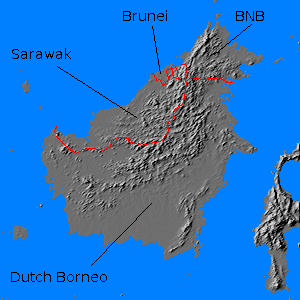![]() The Pacific War Online Encyclopedia
The Pacific War Online Encyclopedia
|
| Previous: Bora Bora | Table of Contents | Next: Boshan |

Borneo is the third largest island in
the world, after Greenland
and New Guinea.
It measures 600 miles (970 km) long and 500 miles (800 km) wide, with a
total area of 284,000 square miles (736,000 km2). In 1941,
it was divided
between Britain
and the Netherlands,
with Britain controlling most of the
northwest coast, which was divided into the sultanates of Sarawak and Brunei, both British
protectorates, and British North Borneo.
Geologically, Borneo is near the southeast extremity of the Asian continent, with the Indonesian island arc marking the boundary with the Indian Ocean plate to the south and the confused boundary with the Australian plate to the east. Its geology remains largely unmapped even at the start of the 21st century, but there are indications that the island is geologically ancient and stable, with a core resembling the highlands of southern Africa.
The interior of Borneo is mountainous, with Mount Kinabalu in the north reaching to 13,455' (4101 meters). However, the interior mountains are granite peaks not reaching more than about 7500' (2300 meters). The coastal regions of Borneo are younger sedimentary beds accreted onto the island core, and it is here that mineral wealth was found in the form of oil. Large oil fields were in production at Miri, Seria, and Lutong in or near Brunei on the northwest coast; at Sandakan, Tarakan, and Balikpapan along the east coast; and at Kuching and Pontianac on the west coast. Borneo crude oil was light enough to be burned directly in ship's boilers, without refining, but when the Japanese turned to this expedient late in the war, they found that the sulfur content was high enough to make boiler steel brittle, eventually ruining the boilers.
There are several large rivers, but these are hazardous to navigate due to shifting bars. The rivers nevertheless provided the only communications to many interior villages, where most of the rice was grown. The south and west coasts are fringed by extensive mangrove swamps.
The Dutch portion of the island had a population
of about 2,230,000 persons, of whom 6000 were Europeans, 2,100,000
Indonesians of at least six ethnicities, 140,000 Chinese, and 13,000 others. British
North Borneo had a population of 252,000 Malayans, 50,000 Chinese, and
a small number of Europeans, while Sarawak had a population of
490,600.
Brunei had a population of just 39,000. The road network was limited to
the immediate vicinity of Banjarmasin,
Balikpapan, and Pontianac
and these were not interconnected.
The oil fields and military facilities of Borneo were important Japanese war objectives in 1942, the latter as stepping stones to Java. The Japanese strategy was to leapfrog down the coast, capturing airfields and ports from which they could cover the next stage of their advance.
The opening stages of the Borneo campaign took place along the
northwest coast and were conducted primarily by elements of 55
Brigade Group and 2 Yokosuka Special Naval Landing Force.
The initial landings took place at Miri
on 15-16 December 1941 and were followed up by landings at Kuching on 24 December, Jesselton on 8 January 1942, and Sandakan on 17 January.
Once west Borneo and Davao were secured, the Japanese were ready to begin leapfrogging down the east Borneo coast. The forces involved here were primarily 56 Brigade and 2 Kure Special Naval Landing Force. Initial landings were at Tarakan on 11 January 1942, and were followed by landings at Balikpapan on 23-24 January and Banjarmasin on 10 February.
The only significant Allied success during this campaign was at Balikpapan, where a squadron of U.S.destroyers surprised a Japanese invasion convoy at anchor and managed to sink several ships before withdrawing without loss. This upset the Japanese timetable by perhaps a day.
The second Borneo campaign took place in the last months of the Pacific War and was controversial. Conducted by Australian troops under MacArthur's command, it was seen as relegating these superb troops to an unnecessary backwater campaign, conducted more for the political purpose of demonstrating Western military power to the people of southeast Asia than for any military purpose. The campaign was conducted primarily by elements of the Australian I Corps.
Borneo was not always a backwater. Because of the importance of its
oil fields, the U.S. Joint Chiefs of Staff urged their British
counterparts to move on Borneo, and some planning took place for an
offensive out of Darwin. However, in July 1944 the British dropped these plans in favor of participating in the invasion of Kyushu scheduled for late 1945. This led to a nasty row at the OCTAGON conference in September 1944, where King
insisted that he wanted no British naval forces in the central Pacific.
King later claimed that he was concerned primarily with the inadequate
British fleet logistical arrangements and felt they could be used more profitably in recovering Singapore, but the conference minutes record no such objection and he may have been speaking from hindsight.
The second Borneo campaign began with OBOE I, a landing at Tarakan conducted by the Australian 26
Brigade on 1 May 1945. OBOE II was conducted by Australian 9 Division,
which seized Brunei (10 June) and Miri (20 June). OBOE VI was conducted
by Australian 7 Division
on 1 July 1945, seizing Balikpapan. It was the
last amphibious
operation of the war.
References
The Pacific War Online Encyclopedia © 2007-2008, 2010-2011 by Kent G. Budge. Index